ECU INFINITI Q50 2021 User Guide
[x] Cancel search | Manufacturer: INFINITI, Model Year: 2021, Model line: Q50, Model: INFINITI Q50 2021Pages: 484, PDF Size: 1.86 MB
Page 40 of 484
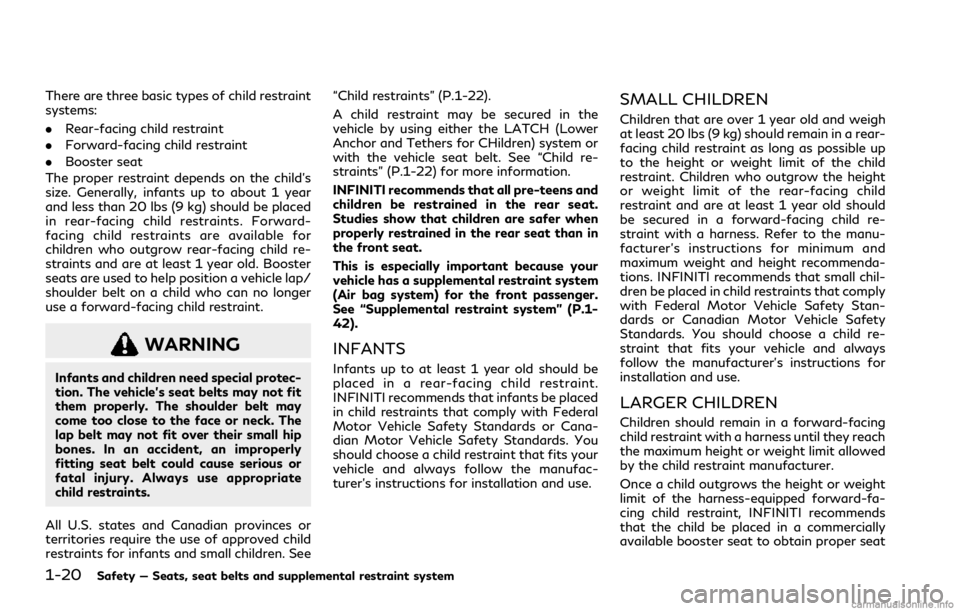
1-20Safety — Seats, seat belts and supplemental restraint system
There are three basic types of child restraint
systems:
.Rear-facing child restraint
. Forward-facing child restraint
. Booster seat
The proper restraint depends on the child’s
size. Generally, infants up to about 1 year
and less than 20 lbs (9 kg) should be placed
in rear-facing child restraints. Forward-
facing child restraints are available for
children who outgrow rear-facing child re-
straints and are at least 1 year old. Booster
seats are used to help position a vehicle lap/
shoulder belt on a child who can no longer
use a forward-facing child restraint.
WARNING
Infants and children need special protec-
tion. The vehicle’s seat belts may not fit
them properly. The shoulder belt may
come too close to the face or neck. The
lap belt may not fit over their small hip
bones. In an accident, an improperly
fitting seat belt could cause serious or
fatal injury. Always use appropriate
child restraints.
All U.S. states and Canadian provinces or
territories require the use of approved child
restraints for infants and small children. See “Child restraints” (P.1-22).
A child restraint may be secured in the
vehicle by using either the LATCH (Lower
Anchor and Tethers for CHildren) system or
with the vehicle seat belt. See “Child re-
straints” (P.1-22) for more information.
INFINITI recommends that all pre-teens and
children be restrained in the rear seat.
Studies show that children are safer when
properly restrained in the rear seat than in
the front seat.
This is especially important because your
vehicle has a supplemental restraint system
(Air bag system) for the front passenger.
See “Supplemental restraint system” (P.1-
42).
INFANTS
Infants up to at least 1 year old should be
placed in a rear-facing child restraint.
INFINITI recommends that infants be placed
in child restraints that comply with Federal
Motor Vehicle Safety Standards or Cana-
dian Motor Vehicle Safety Standards. You
should choose a child restraint that fits your
vehicle and always follow the manufac-
turer’s instructions for installation and use.
SMALL CHILDREN
Children that are over 1 year old and weigh
at least 20 lbs (9 kg) should remain in a rear-
facing child restraint as long as possible up
to the height or weight limit of the child
restraint. Children who outgrow the height
or weight limit of the rear-facing child
restraint and are at least 1 year old should
be secured in a forward-facing child re-
straint with a harness. Refer to the manu-
facturer’s instructions for minimum and
maximum weight and height recommenda-
tions. INFINITI recommends that small chil-
dren be placed in child restraints that comply
with Federal Motor Vehicle Safety Stan-
dards or Canadian Motor Vehicle Safety
Standards. You should choose a child re-
straint that fits your vehicle and always
follow the manufacturer’s instructions for
installation and use.
LARGER CHILDREN
Children should remain in a forward-facing
child restraint with a harness until they reach
the maximum height or weight limit allowed
by the child restraint manufacturer.
Once a child outgrows the height or weight
limit of the harness-equipped forward-fa-
cing child restraint, INFINITI recommends
that the child be placed in a commercially
available booster seat to obtain proper seat
Page 43 of 484
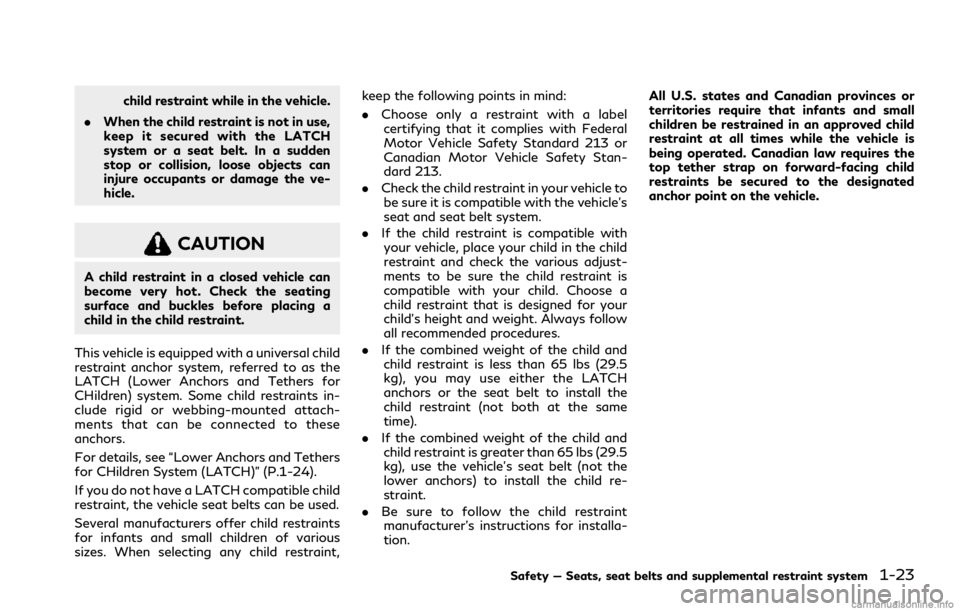
child restraint while in the vehicle.
. When the child restraint is not in use,
keep it secured with the LATCH
system or a seat belt. In a sudden
stop or collision, loose objects can
injure occupants or damage the ve-
hicle.
CAUTION
A child restraint in a closed vehicle can
become very hot. Check the seating
surface and buckles before placing a
child in the child restraint.
This vehicle is equipped with a universal child
restraint anchor system, referred to as the
LATCH (Lower Anchors and Tethers for
CHildren) system. Some child restraints in-
clude rigid or webbing-mounted attach-
ments that can be connected to these
anchors.
For details, see “Lower Anchors and Tethers
for CHildren System (LATCH)” (P.1-24).
If you do not have a LATCH compatible child
restraint, the vehicle seat belts can be used.
Several manufacturers offer child restraints
for infants and small children of various
sizes. When selecting any child restraint, keep the following points in mind:
.
Choose only a restraint with a label
certifying that it complies with Federal
Motor Vehicle Safety Standard 213 or
Canadian Motor Vehicle Safety Stan-
dard 213.
. Check the child restraint in your vehicle to
be sure it is compatible with the vehicle’s
seat and seat belt system.
. If the child restraint is compatible with
your vehicle, place your child in the child
restraint and check the various adjust-
ments to be sure the child restraint is
compatible with your child. Choose a
child restraint that is designed for your
child’s height and weight. Always follow
all recommended procedures.
. If the combined weight of the child and
child restraint is less than 65 lbs (29.5
kg), you may use either the LATCH
anchors or the seat belt to install the
child restraint (not both at the same
time).
. If the combined weight of the child and
child restraint is greater than 65 lbs (29.5
kg), use the vehicle’s seat belt (not the
lower anchors) to install the child re-
straint.
. Be sure to follow the child restraint
manufacturer’s instructions for installa-
tion. All U.S. states and Canadian provinces or
territories require that infants and small
children be restrained in an approved child
restraint at all times while the vehicle is
being operated. Canadian law requires the
top tether strap on forward-facing child
restraints be secured to the designated
anchor point on the vehicle.
Safety — Seats, seat belts and supplemental restraint system1-23
Page 44 of 484
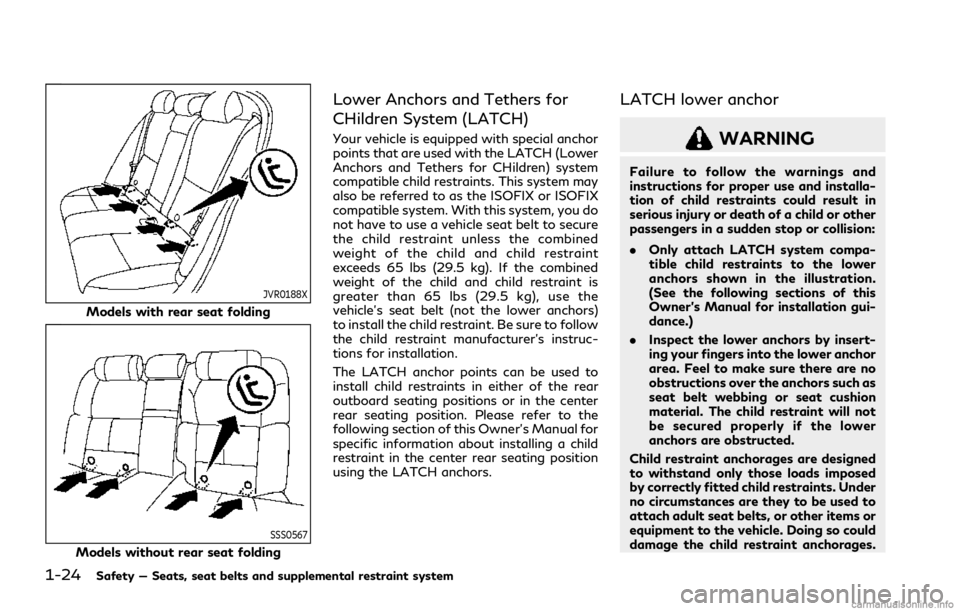
1-24Safety — Seats, seat belts and supplemental restraint system
JVR0188X
Models with rear seat folding
SSS0567
Models without rear seat folding
Lower Anchors and Tethers for
CHildren System (LATCH)
Your vehicle is equipped with special anchor
points that are used with the LATCH (Lower
Anchors and Tethers for CHildren) system
compatible child restraints. This system may
also be referred to as the ISOFIX or ISOFIX
compatible system. With this system, you do
not have to use a vehicle seat belt to secure
the child restraint unless the combined
weight of the child and child restraint
exceeds 65 lbs (29.5 kg). If the combined
weight of the child and child restraint is
greater than 65 lbs (29.5 kg), use the
vehicle’s seat belt (not the lower anchors)
to install the child restraint. Be sure to follow
the child restraint manufacturer’s instruc-
tions for installation.
The LATCH anchor points can be used to
install child restraints in either of the rear
outboard seating positions or in the center
rear seating position. Please refer to the
following section of this Owner’s Manual for
specific information about installing a child
restraint in the center rear seating position
using the LATCH anchors.
LATCH lower anchor
WARNING
Failure to follow the warnings and
instructions for proper use and installa-
tion of child restraints could result in
serious injury or death of a child or other
passengers in a sudden stop or collision:
.Only attach LATCH system compa-
tible child restraints to the lower
anchors shown in the illustration.
(See the following sections of this
Owner’s Manual for installation gui-
dance.)
. Inspect the lower anchors by insert-
ing your fingers into the lower anchor
area. Feel to make sure there are no
obstructions over the anchors such as
seat belt webbing or seat cushion
material. The child restraint will not
be secured properly if the lower
anchors are obstructed.
Child restraint anchorages are designed
to withstand only those loads imposed
by correctly fitted child restraints. Under
no circumstances are they to be used to
attach adult seat belts, or other items or
equipment to the vehicle. Doing so could
damage the child restraint anchorages.
Page 46 of 484
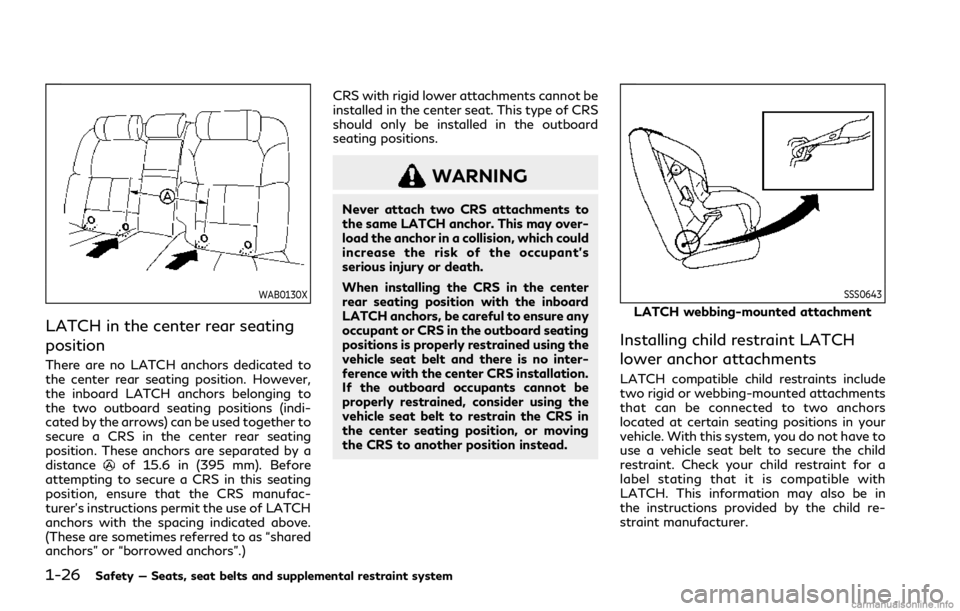
1-26Safety — Seats, seat belts and supplemental restraint system
WAB0130X
LATCH in the center rear seating
position
There are no LATCH anchors dedicated to
the center rear seating position. However,
the inboard LATCH anchors belonging to
the two outboard seating positions (indi-
cated by the arrows) can be used together to
secure a CRS in the center rear seating
position. These anchors are separated by a
distance
of 15.6 in (395 mm). Before
attempting to secure a CRS in this seating
position, ensure that the CRS manufac-
turer’s instructions permit the use of LATCH
anchors with the spacing indicated above.
(These are sometimes referred to as “shared
anchors” or “borrowed anchors”.) CRS with rigid lower attachments cannot be
installed in the center seat. This type of CRS
should only be installed in the outboard
seating positions.
WARNING
Never attach two CRS attachments to
the same LATCH anchor. This may over-
load the anchor in a collision, which could
increase the risk of the occupant’s
serious injury or death.
When installing the CRS in the center
rear seating position with the inboard
LATCH anchors, be careful to ensure any
occupant or CRS in the outboard seating
positions is properly restrained using the
vehicle seat belt and there is no inter-
ference with the center CRS installation.
If the outboard occupants cannot be
properly restrained, consider using the
vehicle seat belt to restrain the CRS in
the center seating position, or moving
the CRS to another position instead.
SSS0643
LATCH webbing-mounted attachment
Installing child restraint LATCH
lower anchor attachments
LATCH compatible child restraints include
two rigid or webbing-mounted attachments
that can be connected to two anchors
located at certain seating positions in your
vehicle. With this system, you do not have to
use a vehicle seat belt to secure the child
restraint. Check your child restraint for a
label stating that it is compatible with
LATCH. This information may also be in
the instructions provided by the child re-
straint manufacturer.
Page 48 of 484
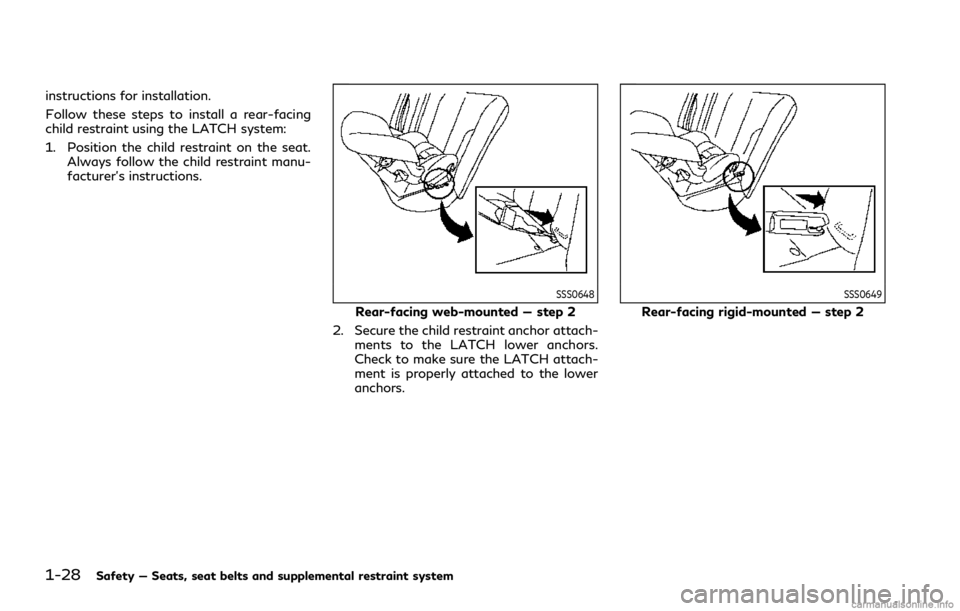
1-28Safety — Seats, seat belts and supplemental restraint system
instructions for installation.
Follow these steps to install a rear-facing
child restraint using the LATCH system:
1. Position the child restraint on the seat.Always follow the child restraint manu-
facturer’s instructions.
SSS0648
Rear-facing web-mounted — step 2
2. Secure the child restraint anchor attach- ments to the LATCH lower anchors.
Check to make sure the LATCH attach-
ment is properly attached to the lower
anchors.
SSS0649
Rear-facing rigid-mounted — step 2
Page 49 of 484
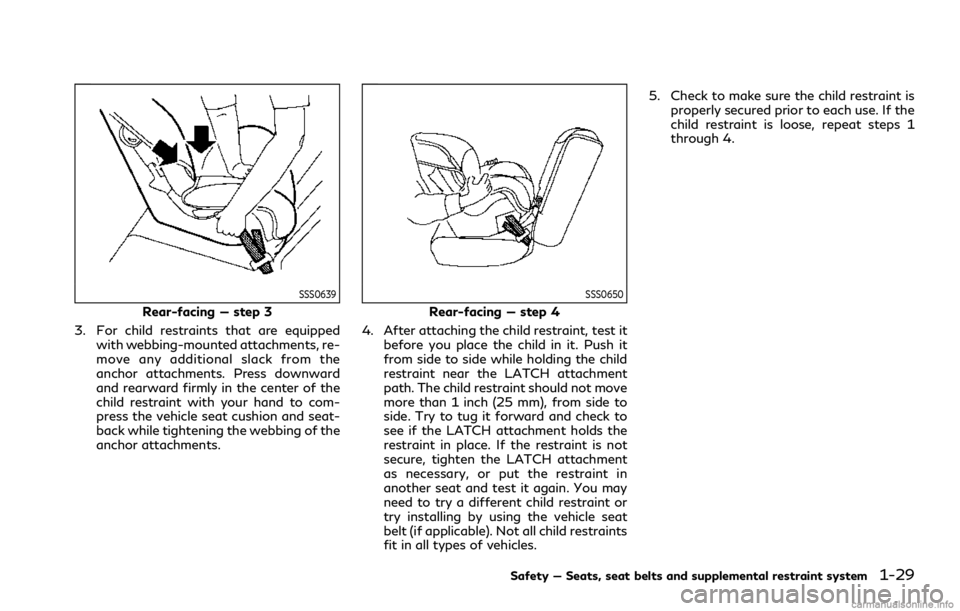
SSS0639
Rear-facing — step 3
3. For child restraints that are equipped with webbing-mounted attachments, re-
move any additional slack from the
anchor attachments. Press downward
and rearward firmly in the center of the
child restraint with your hand to com-
press the vehicle seat cushion and seat-
back while tightening the webbing of the
anchor attachments.
SSS0650
Rear-facing — step 4
4. After attaching the child restraint, test it before you place the child in it. Push it
from side to side while holding the child
restraint near the LATCH attachment
path. The child restraint should not move
more than 1 inch (25 mm), from side to
side. Try to tug it forward and check to
see if the LATCH attachment holds the
restraint in place. If the restraint is not
secure, tighten the LATCH attachment
as necessary, or put the restraint in
another seat and test it again. You may
need to try a different child restraint or
try installing by using the vehicle seat
belt (if applicable). Not all child restraints
fit in all types of vehicles. 5. Check to make sure the child restraint is
properly secured prior to each use. If the
child restraint is loose, repeat steps 1
through 4.
Safety — Seats, seat belts and supplemental restraint system1-29
Page 50 of 484
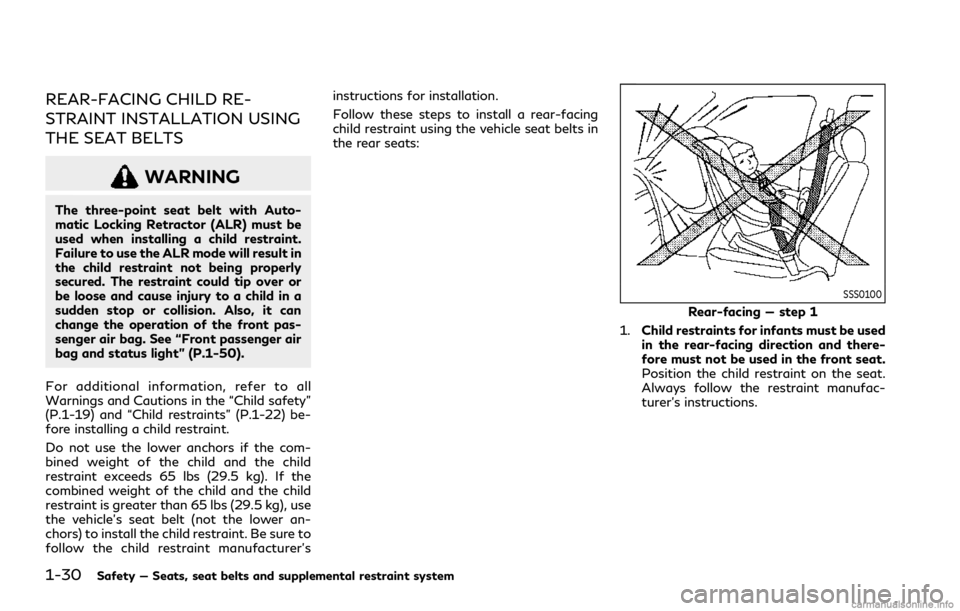
1-30Safety — Seats, seat belts and supplemental restraint system
REAR-FACING CHILD RE-
STRAINT INSTALLATION USING
THE SEAT BELTS
WARNING
The three-point seat belt with Auto-
matic Locking Retractor (ALR) must be
used when installing a child restraint.
Failure to use the ALR mode will result in
the child restraint not being properly
secured. The restraint could tip over or
be loose and cause injury to a child in a
sudden stop or collision. Also, it can
change the operation of the front pas-
senger air bag. See “Front passenger air
bag and status light” (P.1-50).
For additional information, refer to all
Warnings and Cautions in the “Child safety”
(P.1-19) and “Child restraints” (P.1-22) be-
fore installing a child restraint.
Do not use the lower anchors if the com-
bined weight of the child and the child
restraint exceeds 65 lbs (29.5 kg). If the
combined weight of the child and the child
restraint is greater than 65 lbs (29.5 kg), use
the vehicle’s seat belt (not the lower an-
chors) to install the child restraint. Be sure to
follow the child restraint manufacturer’s instructions for installation.
Follow these steps to install a rear-facing
child restraint using the vehicle seat belts in
the rear seats:
SSS0100
Rear-facing — step 1
1. Child restraints for infants must be used
in the rear-facing direction and there-
fore must not be used in the front seat.
Position the child restraint on the seat.
Always follow the restraint manufac-
turer’s instructions.
Page 52 of 484
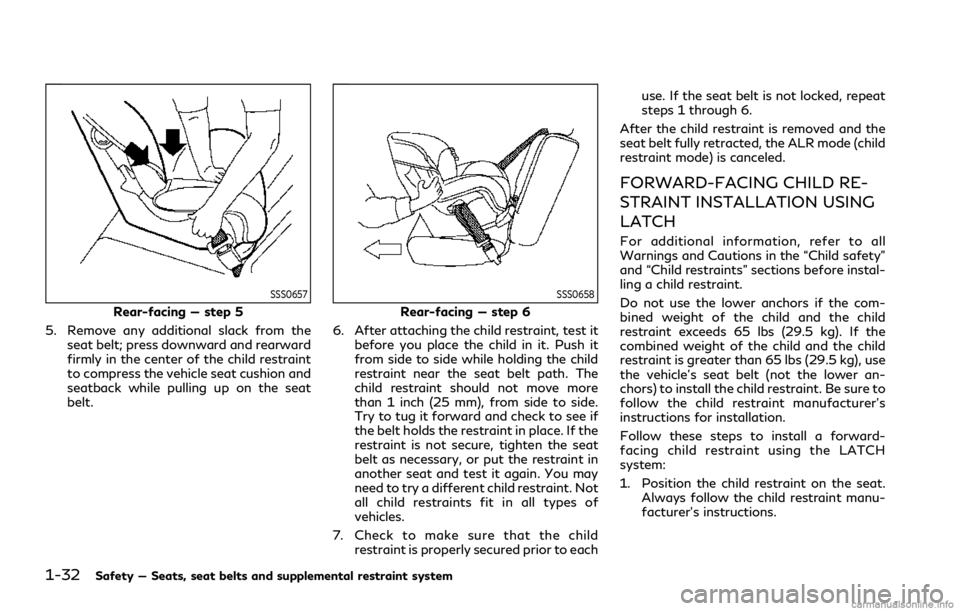
1-32Safety — Seats, seat belts and supplemental restraint system
SSS0657
Rear-facing — step 5
5. Remove any additional slack from the seat belt; press downward and rearward
firmly in the center of the child restraint
to compress the vehicle seat cushion and
seatback while pulling up on the seat
belt.
SSS0658
Rear-facing — step 6
6. After attaching the child restraint, test it before you place the child in it. Push it
from side to side while holding the child
restraint near the seat belt path. The
child restraint should not move more
than 1 inch (25 mm), from side to side.
Try to tug it forward and check to see if
the belt holds the restraint in place. If the
restraint is not secure, tighten the seat
belt as necessary, or put the restraint in
another seat and test it again. You may
need to try a different child restraint. Not
all child restraints fit in all types of
vehicles.
7. Check to make sure that the child restraint is properly secured prior to each use. If the seat belt is not locked, repeat
steps 1 through 6.
After the child restraint is removed and the
seat belt fully retracted, the ALR mode (child
restraint mode) is canceled.
FORWARD-FACING CHILD RE-
STRAINT INSTALLATION USING
LATCH
For additional information, refer to all
Warnings and Cautions in the “Child safety”
and “Child restraints” sections before instal-
ling a child restraint.
Do not use the lower anchors if the com-
bined weight of the child and the child
restraint exceeds 65 lbs (29.5 kg). If the
combined weight of the child and the child
restraint is greater than 65 lbs (29.5 kg), use
the vehicle’s seat belt (not the lower an-
chors) to install the child restraint. Be sure to
follow the child restraint manufacturer’s
instructions for installation.
Follow these steps to install a forward-
facing child restraint using the LATCH
system:
1. Position the child restraint on the seat. Always follow the child restraint manu-
facturer’s instructions.
Page 53 of 484

SSS0645
Forward-facing web-mounted — step 2
2. Secure the child restraint anchor attach- ments to the LATCH lower anchors.
Check to make sure the LATCH attach-
ment is properly attached to the lower
anchors.
If the child restraint is equipped with a
top tether strap, route the top tether
strap and secure the tether strap to the
tether anchor point. See “Installing top
tether strap” (P.1-34). Do not install child
restraints that require the use of a top
tether strap in seating positions that do
not have a top tether anchor.
SSS0646
Forward-facing rigid-mounted — step 2
3. The back of the child restraint should be secured against the vehicle seatback.
If necessary, adjust or remove the head
restraint to obtain the correct child
restraint fit. If the head restraint is
removed, store it in a secure place. Be
sure to reinstall the head restraint when
the child restraint is removed. See “Head
restraints/headrests” (P.1-8) for head
restraint adjustment information.
If the seating position does not have an
adjustable head restraint and it is inter-
fering with the proper child restraint fit,
try another seating position or a differ-
ent child restraint.
SSS0647
Forward-facing — step 4
4. For child restraints that are equipped with webbing-mounted attachments, re-
move any additional slack from the
anchor attachments. Press downward
and rearward firmly in the center of the
child restraint with your knee to com-
press the vehicle seat cushion and seat-
back while tightening the webbing of the
anchor attachments.
5. Tighten the tether strap according to the manufacturer’s instructions to remove
any slack.
Safety — Seats, seat belts and supplemental restraint system1-33
Page 54 of 484

1-34Safety — Seats, seat belts and supplemental restraint system
SSS0638
Forward-facing — step 6
6. After attaching the child restraint, test it before you place the child in it. Push it
from side to side while holding the child
restraint near the LATCH attachment
path. The child restraint should not move
more than 1 inch (25 mm), from side to
side. Try to tug it forward and check to
see if the LATCH attachment holds the
restraint in place. If the restraint is not
secure, tighten the LATCH attachment
as necessary, or put the restraint in
another seat and test it again. You may
need to try a different child restraint. Not
all child restraints fit in all types of
vehicles. 7. Check to make sure the child restraint is
properly secured prior to each use. If the
child restraint is loose, repeat steps 1
through 6.
WAB0131X
Anchor point
Top tether strap
Installing top tether strap
WARNING
Child restraint anchorages are designed
to withstand only those loads imposed
by correctly fitted child restraints. Under
no circumstances are they to be used to
attach adult seat belts, or other items or
equipment to the vehicle. Doing so could
damage the child restraint anchorages.
The child restraint will not be properly
installed using the damaged anchorage,